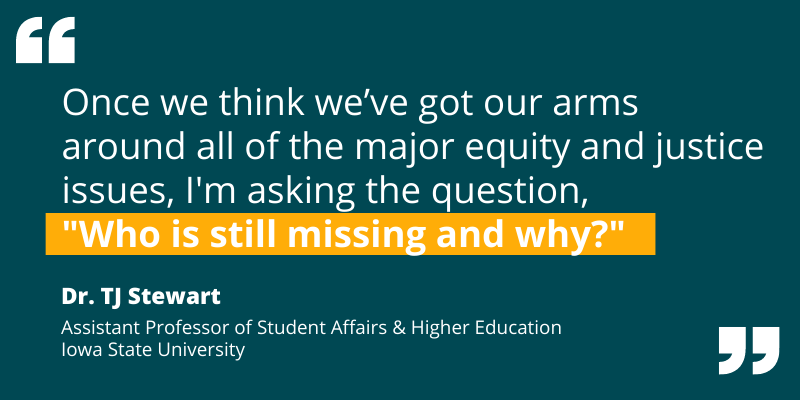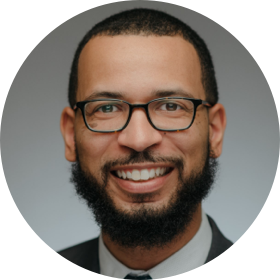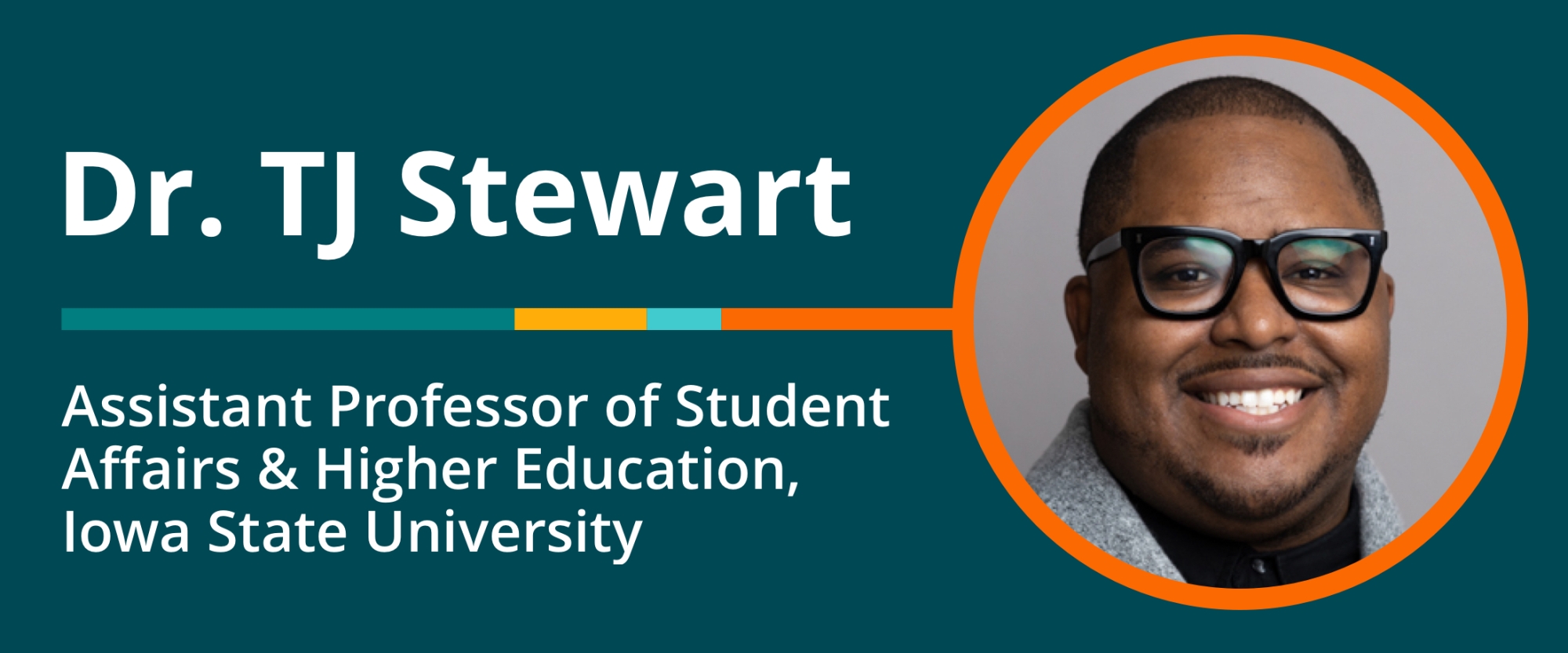We were honored to talk with Dr. TJ Stewart, Assistant Professor of Student Affairs & Higher Education at Iowa State University, for the Scholarship to Practice Podcast. He spoke about unrecognized student populations in need of equitable treatment, the myths and realities of critical race theory, and faculty and staff activism in the interest of social justice.
Excluded Student Populations
Dr. Stewart's research interests include college students with stigmatized identities, identity-based student activism, and critical qualitative methodologies. We asked him about students that he describes as "at the margins of the margins."
"Once we think we’ve got our arms around all of the major equity and justice issues around race, gender, and class," he explained, "I'm asking the question, 'Who is still missing and why?' We know these students exist but are not necessarily centered in our everyday equity and justice conversations or work."

For higher ed leaders hoping to improve campus equity through outreach to these populations, Dr. Stewart offered a caveat: "These students are sometimes not visible because they choose not to be. Some are not sure that they can trust their institution or institutional leaders. We have to show that we don’t mean them harm and want to support them. In some ways, being in the margins operates as a protective feature, and so I always caution that we don’t want to recklessly pull folks in unwillingly, but I do think it’s important to focus on who is not present, and how we can bring them center, if it makes sense to do so."
Who's Missing?
There's a wide range of invisible student subsets beyond the margins of traditional justice work. Dr. Stewart described the spectrum of those excluded from the mainstream:
"How are fat students experiencing fat phobia and sizeism? I also do work around college students engaged in sex work as their labor choice. In the last several years, we’ve seen a lot of work around unhoused students; students who are food insecure; students transitioning from foster care and the barriers that they may face. I think about Dr. Adrian Huerta, who does work with formerly gang-affiliated youth coming to higher education. Students who have criminal records. Disabled students broadly – I ascribe to the social model of disability, that people are more disabled by society and structures than they are by their bodies and diagnoses, so therefore they’re actively being disabled."
Sizeism
Dr. Stewart has extensively studied the issues of fat phobia and sizeism on campus, the signaling that excludes larger people from the promise of higher education. He shared two views of this bias.
"One, it’s social and cultural, so it can manifest as ideas and beliefs about fat people," he said. "Do these students have violent experiences based on how people treat them socially or academically? Do we think about that as a form of bias, as an identity? The other piece is the physical, so I think about Strange and Banning’s work about the physical aggregate. Physical environments impact students – what type of furniture do we buy? In old buildings, we have classrooms where chairs were bolted to the floor and built for students in the ’50s. Furniture should be inclusive of body size. We would not expect an 'average' student to sit on some rickety chair that has a piece of iron digging into their side. That’s a safety issue.
"There are a lot of fat-bodied students who experience places where they are not able to be comfortable, where they don’t fit in the classroom, in the residence hall," Dr. Stewart continued. "We know athletes might get preference in certain assigned spaces. How radical would it be if we thought about that for larger students? What can we do with the resources that we have for students who might require them? But we have to first recognize that it’s an issue, so it requires some investment of resources, in having conversations with these students."
Student Sex Workers
The idea of students engaged in sex work is a potentially uncomfortable topic, so we asked Dr. Stewart what higher ed leaders might need to understand about this population.
"We have to be careful that we don’t have uncritical conflations with sex work and sex trafficking," he observed. "Those are not one and the same. Sex work is not inherently exploitative or degrading. But sex workers, like all of us, are engaging in labor under capitalism, right? That means a wide spectrum of experiences and pathways. I think these students deserve our respect, attention, and support, if they so desire it. And they're on every campus engaging in various forms of sex work, because technology affords opportunities to engage in it. They’re not a group to be afraid of. They’re not causing trouble or harm. I am of the belief that all students deserve support, inclusive of their labor choices."
Perceived Pathology and Stigma
Dr. Stewart suggested that administrative policy decisions about marginalized students might not be the best starting point.
"I had conversations with students as a practitioner where some of them were revealing their lives to me," he recalled, "but I was not in a high place to effect systems and structures that could be supportive. I think the people that can do that should be having conversations with the practitioners dealing with these students every day, who may know of these stories and students. It allows us to start brainstorming without those students revealing who they are, because they’ve revealed themselves to the folks that they trust."
Dr. Stewart also addressed why some students choose invisibility. "What experiences are the students having that might be pathologized?" he asked. "Or there may be a corresponding stigma. That has been a connective feature. Is there some stigma or pathology associated with their experience so it’s not necessarily rendered as a justice issue? Fat students, for example, the prevalent thought frame might be, 'Well, that’s something you can and probably should change, so why should I think about that as a justice issue?' That’s the absolutely wrong thought to have. But then that would be a reason why a student doesn’t vocalize their experiences, so that would be a way to start thinking about it."
Critical Race Theory: Myth and Reality
With so much recent political rhetoric around critical race theory, we asked Dr. Stewart to define what CRT is and how it might be useful.
"CRT was created approximately 40 years ago by legal scholars," he explained. "It’s a framework that allowed us to think about inequities that exist in law. It’s concerned with outcomes. Two questions animate that theory. 'Why does racial inequality persist?' Initially that question was in legal structures, but it extends to social and political life, to education. It would be absurd for us not to believe that the inequities that legal scholars have pointed out do not trickle into all our systems, so we also ask, 'How do we create racial equity?'
"The myth is that CRT is a catchall for diversity, inclusion, or even history," he went on, "so a lot of the attacks have been rooted on any language around diversity, inclusion, equity, or justice. That should be alarming, because it really underscores this trend of trying to peel back what little progress we’ve made around racial justice and diversity broadly. The other myth is that CRT is somehow dangerous, divisive, or inconsequential to the work of higher ed. So many of CRT's ideas are rooted in things that philosophers and thinkers discussed over 100 years ago, so it’s not new and it’s not suddenly a threat.
"I cringe every time I hear the phrase equal opportunity in education," Dr. Stewart admitted. "If people just have the opportunity, they can be successful. But as educators, thinkers, and evaluators, we have to ask, 'Why aren’t the outcomes proportional to the opportunities?' So what CRT does is allow us a framework to understand why these outcomes are not equal, particularly around race. And if we step back and say, 'What would it mean if we all agreed that racism was normal?' – that’s a tenet of CRT – I think it would lead us to some interesting places, because critical theory is concerned with systems and structures and trying to transform them. So CRT actually is a tool that would be incredibly useful for us."
Good Trouble
Dr. Stewart shared that sometimes, in the interest of justice, it may be necessary to subvert the rules.
"That was my personal ethic as a practitioner," he told us, "and I know that can be a scary space for us, but I just could not bear to see students harmed with no formal redress, reprieve, or recognition of that problem. And so each of us will have to search our consciences, hearts, or minds around what that looks like. But I do think that if we can provide informal relief, we should, because we know that changing policy in higher education is like turning a cruise ship. Students cannot always wait for those processes to materialize, so what is it that I can do within my locus of control?
"Some of those students are revealing their experiences, who they are, and what they’re going through to folks in high-touch-point student service areas," said Dr. Stewart. "That helps underscore a pathway through, because sometimes in our institutions, we’re so used to systems, structures, and the way they oppress that it’s hard to imagine a way through them. So when we’re able to be subversive to support a student, it’s not because we’re trying to be a troublemaker. I think about Congressman John Lewis' idea of 'good trouble,' and it then propels us into a conversation to say, 'Nuh-uh, there are things that we can do, and I'm going to tell why because I did this thing for students, and that was something that was helpful to them.' I have never regretted a time when I was able to support a student in that way, and it often led to more systemic and structural changes."
Note: This interview in the Scholarship to Practice Series originally aired on August 19, 2021 as part of the University Innovation Alliance’s Innovating Together Podcast, appearing live on Facebook, Twitter, and LinkedIn.
Links Mentioned in This Episode
• Dr. TJ Stewart
• Iowa State University
• Unhoused students; students who are food insecure ("Facing the Insecurities of #RealCollege: A Conversation With Sara Goldrick-Rab, Professor of Sociology and Medicine, Temple University," UIA, 4/22/21)
• Dr. Adrian Huerta (Assistant Professor, Rossier School of Education at the University of Southern California, whose research focuses on boys and young men of color, college access and equity, and gang-associated youth)
• Strange and Banning’s work (Design for Learning: Creating Campus Environments for Student Success, by C. Carney Strange and James H. Banning)
• Critical race theory ("What Is Critical Race Theory, and Why Is It Under Attack?" by Stephen Sawchuk, Education Week, 5/18/21)
• Good trouble ("How We Rise: Five things John Lewis taught us about getting in good trouble" by Rashawn Ray, Brookings.edu, 7/23/20)
Keeping Up With Dr. TJ Stewart
You can find Dr. Stewart at his website terahjay.com, on Twitter, YouTube, Medium, Instagram, Linkedin, and Google Scholar.
Bios of Guest Luminary and Co-Hosts

Guest Luminary: TJ Stewart, Assistant Professor of Student Affairs & Higher Education, Iowa State University
Dr. Terah "TJ" Stewart has focused his education and career on higher education and human resources, specifically diversity, equity, and justice work. He is interested in promoting the ways that equity and diversity provide brave, bold, critical, and power-conscious approaches to serve as a catalyst for advancement in organizations. Dr. Stewart earned a B.A. in psychology, an M.A. in higher education and human affairs, and an M.L.H.R. from the Ohio State University. He went on to earn a Ph.D. from University of Georgia's College of Education, where he researched populations within the margins of the margins. His work at Ohio State included Program Manager at the Office of the Vice President for Student Life, and Assistant Director of the Multicultural Center. He is especially proud of his rewarding internship with the H.R. production team at PDI/DreamWorks Animation. Dr. Stewart specializes in qualitative research, critical theory, Black experiences in higher education, fat-body politics, sex work, and anti-Black racism.

Co-Host: Bridget Burns, Executive Director, University Innovation Alliance
Dr. Bridget Burns is the founding Executive Director of the University Innovation Alliance (UIA). For the past decade, she has advised university presidents, system chancellors, and state and federal policy leaders on strategies to expand access to higher education, address costs, and promote completion for students of all backgrounds. The UIA was developed during Bridget’s tenure as an American Council on Education (ACE) Fellowship at Arizona State University. She held multiple roles within the Oregon University System, including serving as Chief of Staff and Senior Policy Advisor, where she won the national award for innovation in higher education government relations. She was a National Associate for the National Center for Public Policy and Higher Education, and has served on several statewide governing boards including ones governing higher education institutions, financial aid policy, and policy areas impacting children and families.

Co-Host: Derrick Tillman-Kelly, Director, University Innovation Alliance Fellows Program and Network Engagement
Dr. Derrick L. Tillman-Kelly serves as the Director of the UIA Fellows Program and Network Engagement for the University Innovation Alliance. He previously served in multiple roles at The Ohio State University, including as the inaugural UIA Fellow and special assistant to the director of the Center for Higher Education Enterprise. Dr. Tillman-Kelly earned his Ph.D. in educational policy and leadership with a specialization in higher education and student affairs from Ohio State; a master’s degree in higher education and student affairs from Indiana University; and a bachelor’s degree from Illinois Wesleyan University.
About Scholarship to Practice
Scholarship to Practice is an event series that happens live on Facebook, Twitter, and LinkedIn. It also becomes a podcast episode. We interview higher education scholars, researchers, and academics as we surface relevant research on topics that administrators often wonder about, and examine how a practitioner or administrator could apply this learning in real-time to improve student success. At the UIA, we know that we need to bridge that gap between scholarship and practice if we’re going to stand a chance of improving student success. We all need to work together leveraging research in the field and identifying where we need more research to support greater innovation in higher ed. With its short and conversational format, this show is designed to help bridge that gap by elevating the relevant research we all could be using in our daily lives.
Rate, Review & Subscribe
Learn why hundreds of people have rated this new podcast 5 stars! Please join others and rate and review this podcast. This helps us reach and inform more people -- like you -- to help increase the number and diversity of college graduates in the United States.
Click here, scroll to the bottom, tap to rate with five stars, and select “Write a Review.” Then be sure to let us know what you loved most about the episode! Also, if you haven’t done so already, subscribe to the podcast. We’ll be adding a bunch of bonus episodes to the feed and, if you’re not subscribed, there’s a good chance you’ll miss out.

